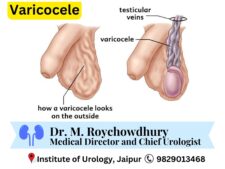In this article, we will discuss the causes, symptoms, and treatment of priapism.

What is Priapism?
Priapism is a medical condition characterized by an erection that lasts for more than four hours without sexual stimulation. This condition is a medical emergency that requires immediate treatment. Priapism can affect males of all ages, but it is most common in men between the ages of 20 and 50.
This prolonged erection is painful and can damage the penis permanently if not treated promptly.
What are the Types of Priapism?
There are two main types of priapism: ischemic and non-ischemic. These types of priapism have different causes and treatments.
Ischemic Priapism – Ischemic priapism, also known as low flow priapism, is the most common type of priapism. It occurs when the blood flow to the penis is blocked or reduced, leading to a lack of oxygen and nutrients to the penis tissues. This can cause damage to the tissues and nerves in the penis, leading to long-term erectile dysfunction if not treated promptly.
Ischemic priapism is usually painful and can last for several hours or even days if left untreated. It is more common in men with sickle cell anemia, as the abnormal sickle-shaped red blood cells can block the blood vessels in the penis. Ischemic priapism can also be caused by medications, such as blood thinners, and recreational drugs, such as cocaine.
Non-Ischemic Priapism – Non-ischemic priapism, also known as high flow priapism, is less common than ischemic priapism. It is usually painless and occurs when there is an injury to the penis or the area around it. This injury can cause a ruptured artery or vein, leading to an increase in blood flow to the penis. Non-ischemic priapism can also be caused by a congenital abnormality of the blood vessels in the penis.
Non-ischemic priapism is usually not a medical emergency, and the erection may last for several hours or even days. However, if the erection lasts for more than four hours, medical attention should be sought to prevent complications.
What are the Causes of Priapism?
There are several causes of priapism, including:
Sickle cell anemia: This is a genetic condition that affects the red blood cells, causing them to become stiff and form a crescent shape. This shape makes it difficult for the blood to flow through the blood vessels, leading to priapism.
Leukemia: This is a type of blood cancer that affects the white blood cells. The cancerous cells can block the blood vessels, leading to priapism.
Medications: Certain medications, such as those used to treat erectile dysfunction, can cause priapism as a side effect.
Spinal cord injuries: Injuries to the spinal cord can disrupt the nerve signals that control the blood flow to the penis, leading to priapism.
Alcohol and drug abuse: Alcohol and drug abuse can cause priapism by affecting the blood flow to the penis.
Other Causes: Some less common causes may include conditions like scorpion sting, spider bite, Metabolic disorder like gout or amyloidosis, syphilis and lastly some cancers involving the penis may cause priapism.
What are the Symptoms of Priapism?
The main symptom of priapism is a persistent and painful erection that lasts for more than four hours. Other symptoms may include:
- Swelling and tenderness in the penis
- Difficulty urinating
- Fever
- Chills
- Rapid heartbeat
- Shortness of breath
If you experience any of these symptoms, seek medical attention immediately. Our hospital number is (0091) 9829013468.
How is Priapism Treated?
The treatment of priapism depends on the underlying cause of the condition. The first step in treating priapism is to identify the cause and address it. The following treatments may be used to treat priapism:
Medications: Medications may be used to treat priapism, depending on the cause. For example, medication may be used to treat sickle cell anemia, which is a common cause of priapism. Besides oral medication, there are certain medications available that can be directly injected into the penis for immediate relief in case of emergency.
Aspiration and irrigation: Aspiration and irrigation is a procedure that involves draining the blood from the penis and then flushing it with a saline solution to remove any blood clots. This procedure is usually performed in the hospital under local anesthesia.
Surgery: Surgery may be necessary to treat priapism in some cases. The surgery may involve placing a shunt in the penis to redirect the blood flow or removing the blood clot that is causing the priapism.
Ice packs: Ice packs may be used to reduce swelling and pain in the penis.
What are the Complications of Priapism?
If left untreated or not treated adequately, priapism can lead to several complications, including:
Erectile Dysfunction: Priapism can cause permanent damage to the tissues and nerves in the penis, leading to long-term erectile dysfunction.
Fibrosis: Prolonged and untreated priapism can lead to the formation of scar tissue in the penis, causing a condition called fibrosis. This can result in a curvature of the penis during erection, making sexual intercourse difficult or impossible.
Infection: The prolonged presence of blood in the penis can increase the risk of infection. Infections of the penis can be serious and may require antibiotics and surgery.
Gangrene: In rare cases, prolonged priapism can lead to gangrene, a condition in which the tissues in the penis die due to a lack of blood flow. This can be a medical emergency and may require surgery to remove the affected tissue.
Psychological Distress: Priapism can cause significant psychological distress, anxiety, and depression, especially if it leads to permanent erectile dysfunction.
Can we prevent Priapism?
While priapism cannot always be prevented, there are some measures that may reduce the risk of developing priapism or help to prevent recurrent episodes. Here are some tips to consider:
Manage Underlying Medical Conditions: Some medical conditions, such as sickle cell anemia, leukemia, and certain types of cancer, can increase the risk of developing priapism. It’s important to manage these conditions effectively to prevent complications and reduce the risk of priapism.
Avoid Recreational Drugs: Recreational drugs, such as cocaine and marijuana, can increase the risk of developing priapism. If you use these drugs, consider quitting or seeking professional help to overcome addiction.
Avoid Certain Medications: Certain medications, such as blood thinners and antidepressants, can increase the risk of developing priapism. If you are taking these medications, talk to your doctor about the risks and benefits and whether an alternative medication may be suitable.
Use Erection-Inducing Medications with Caution: Erection-inducing medications, such as sildenafil (Viagra), tadalafil (Cialis), and vardenafil (Levitra), can cause priapism in rare cases. If you are prescribed these medications, use them according to the prescribed dosage and follow your doctor’s instructions.
Stay Hydrated: Dehydration can increase the viscosity of the blood, making it more likely to clot and cause priapism. It’s important to stay hydrated by drinking plenty of water and avoiding alcohol and caffeine, which can dehydrate the body.
Best Doctor & Hospital for Priapism – Institute of Urology, C Scheme, Jaipur
With this article, our main goal is to create awareness about Priapism. It is a medical emergency, and when left unchecked, it can cause a plethora of complications for the patient. Therefore, there is no need to be shy about absolutely any health related concerns. Institute of Urology Hospital in C Scheme, Jaipur is an advanced dedicated centre to Men’s health related problems and are available 24 x 7 in case of emergencies.
For more queries or questions, please do not forget to give me a call directly on 9829013468 (Dr. M. Roychowdhury). We are here if you need help and we promise optimal treatment to the best of our expertise and abilities. We encourage prior appointments as they help us attend to you without any waiting time and in a more organised manner.







